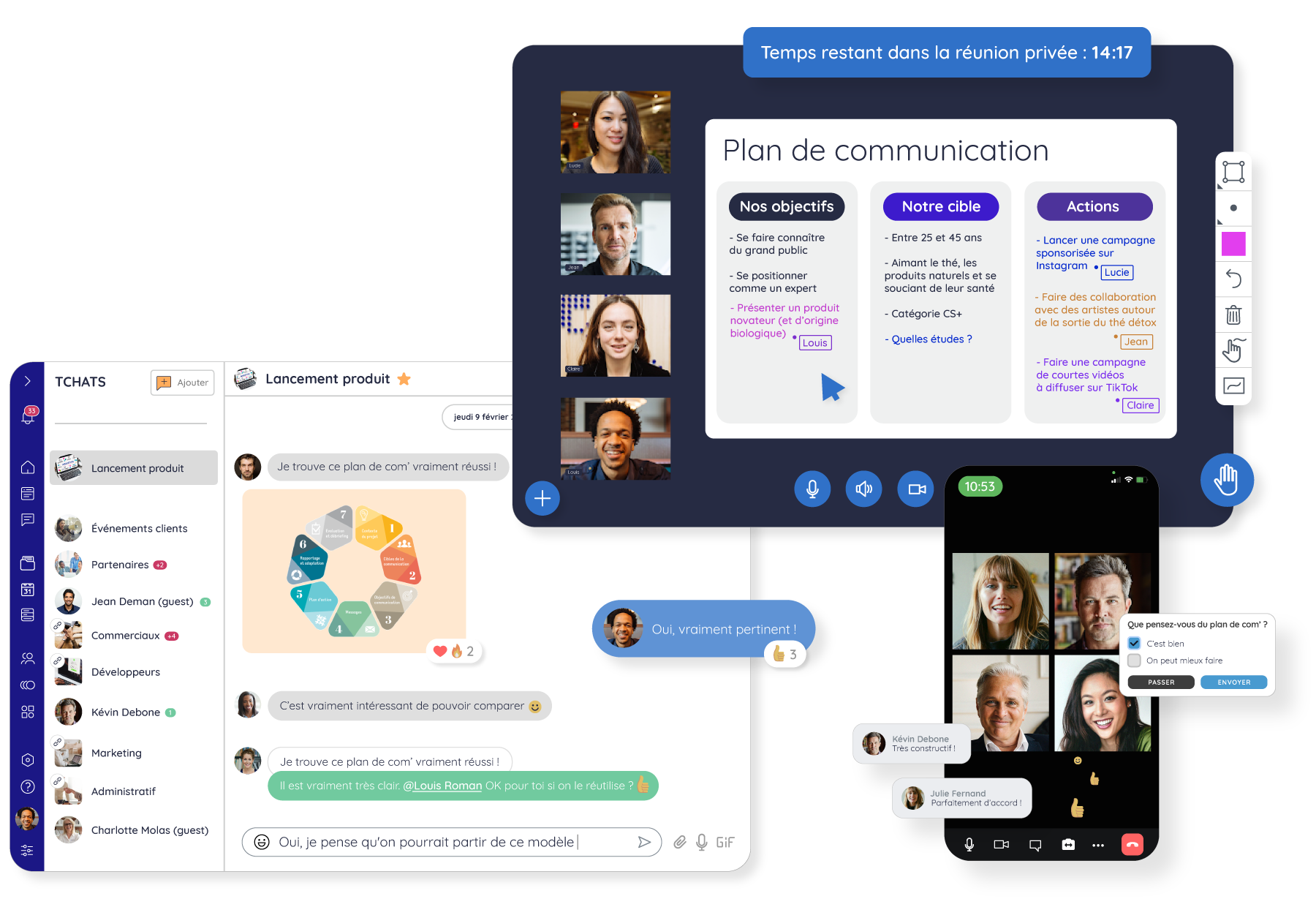Does your team already use a collaborative platform? Are you perhaps pondering one? Maybe you’re simply curious about finding a better way to boost your productivity. For whatever reason, you’ve come to the right place!
Collaborative work platforms offer considerable benefits for productivity. They can improve internal communication, project management, remote working, meetings and much more. Ultimately, they can help optimize virtually every aspect of your organization’s productivity.
In this article, we’ll explore how you can boost your productivity with a collaborative platform! Discover best practices and concrete examples to optimize the use of this powerful tool and transform the way you work!
Choose the right tool
Choosing the right tool is key to boosting productivity with a collaborative platform. But what is a “good” tool in this context? It’s not just a question of performance, design, or functionality. Above all, it’s a tool that meets all you and your team’s needs, day after working day!
The good news is that there are plenty of options to pick from! However, this can ultimately make things challenging. 😨 That’s why it’s important to think about your ongoing projects and issues. For example:
- If your internal communication is inefficient, and you need to make it more instantaneous and transparent, this should be a selection factor.
- If collaboration becomes burdensome because your teams are geographically dispersed, consider accessibility.
- If your priority is data hosting, switching to a sovereign SaaS solution may be one of your requirements.
Also, involve your teams in the decision-making process to ensure you choose the right tool for all stakeholders. After all, they’re the ones who will be using the tool on a daily basis. Organize dedicated meetings, gather their feedback, and identify their specific
needs. This helps you pick the platform that will not only meet your expectations as a manager, but also those of the people who will ramp up your organization’s productivity! 📈

For example, Talkspirit is an all-in-one collaboration platform, accessible to all your employees (even those who work remotely). With Talkspirit, you can :
- communicate live via chat and videoconferencing,
- share information via a home portal, news feed and library,
- or collaborate remotely via groups, and an office suite enabling document co-publishing in real time.
To find out more, request a demo or talk to one of our experts! 😃
Roll out your platform
Once a tool has been selected, deploying a collaborative platform can be a complex process. Here, then, are a few essential best practices to ensure an effective implementation of your tool, which will help you gain in productivity later on! 📊
Start small
As part of an initial test with teams, opt for a small-scale rollout with a pilot group. A gradual approach ensures a smoother transition to widespread use of the collaborative platform. By starting small, you have the opportunity to learn, refine and adapt the platform based on feedback, guaranteeing a successful rollout and continuous improvement in productivity.
Personalize the platform
This involves configuring the platform to best meet your needs. 💡 Our advice: Avoid redundancy by making sure it integrates well with the software you already use. The aim is to create the right environment that allows your teams to smoothly and successfully adopt it. This will make it easier for them to use the software in the future, and help you to stay more productive over the long haul. How many teams does your company have? Organize them into thematic groups! Who’ll manage these groups? Identify ideal candidates among all your talent! It’s time to make this platform YOUR space.
Train, raise awareness, and support change
By offering appropriate training to future platform users, you enable them to make the most of the platform’s functionalities, thereby boosting their productivity. Awareness-raising complements training by giving meaning to the change and explaining how the platform can enhance efficiency. To ensure a successful transition to this new way of working, it is essential to follow through with the transition in order to minimize resistance and maximize benefits.
Measure and optimize
Set up key performance indicators (KPIs) and closely monitor them to follow the platform’s impact on productivity. For example, you can measure: the platform’s adoption rate, engagement rate, or number of monthly/daily active users. In addition, gathering feedback from users can also be useful. By collecting this data regularly, you can measure the effectiveness of your collaborative platform and make adjustments wherever needed. For example, if project delivery times decrease after the platform has been set up, it’s a sign that productivity is on the right track!
Several companies have succeeded in boosting their productivity thanks to a collaborative platform! One example is CNPF (National Forest Ownership Center), which uses Talkspirit to centralize exchanges with its 500+ employees scattered across France.
Good practices to boost productivity
Using your collaborative platform doesn’t just happen on its own! To be effective, you need to be aware of specific best practices—key to ensuring that your investment in this tool ultimately translates into increased productivity. It’s not enough to simply have access to this powerful tool. You’ll also need to know how to best put it to use! Here are a few examples of how you can make the most of it:
Implement information governance
Information governance structures the management of information within your organization, making a major contribution to productivity. With information governance in place, users can quickly find the information they need without wasting time constantly searching. It’s important to remember that the key is not speed, but fluidity! To achieve this, define clear rules for information management within the platform. Next, identify managers who will ensure that data is organized, relevant, and accessible. That’s it!
Create a user charter
This charter is the heart of your platform! It sets out the rules by which all users should abide. By doing so, it creates a more efficient collaborative environment and serves as a reference for users. By having clear guidelines, your team members will know how to use the platform constructively and respectfully. This encourages more focused communication and avoids any misunderstandings that can slow down work.
Ask managers to lead by example
Managers have a pivotal role in the proper use of the platform. By regularly engaging to communicate, share information, and collaborate, they send a strong message—one that the platform stands center stage in the company’s culture. Managers’ involvement is an infallible lever for boosting team buy-in and commitment. What’s more, by naturally encouraging other team members to explore the tool to improve their own productivity.
Limit meetings
Rather than scheduling a meeting for every little detail, encourage the use of chat functions, comments on shared documents, or posts on a news feed. These strategies encourage asynchronous communication, and that means team members can collaborate and exchange ideas without needing to physically (or even virtually) meet all the time. The result? Less time wasted in (let’s be honest, often pointless) meetings, and more time to concentrate on productive tasks!
Favor the use of chat rather than internal email
Streamline! Chat exchanges are typically quicker and more direct, enabling questions to be resolved or decisions to be taken more quickly. You can encourage your teams to use chat for quick discussions, such as clarifications on an ongoing project or real-time updates. This prevents inboxes from filling up with messages that can be handled more efficiently via chat. By adopting this approach, you streamline internal communication, contributing to greater productivity within your team.
In conclusion
You now know all about the significant impact a collaborative platform can have on an organization’s productivity and efficiency! By following good deployment practices, training your teams, measuring results, and encouraging effective use, you’re well on your way to harnessing this tool’s full potential. With the rapid evolution of technology, it’s essential to stay up to date and adopt solutions that not only facilitate teamwork, but also foster a culture of collaboration and efficiency within your organization.
Ready now to set up your own collaborative platform? Contact our team today for personalized support throughout your project:




